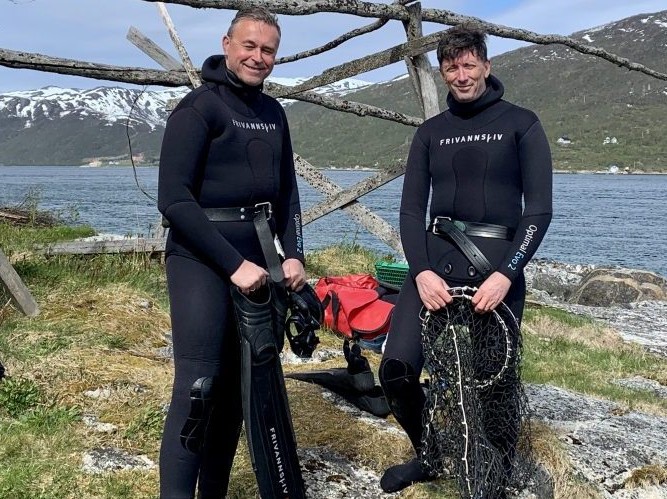DIVING FOR SEA URCHINS WITH A MINISTER
On Monday 15 June, a two-minute news segment featuring the AquaVitae project aired on TV2 Nyhetskanalen, a nationwide news channel in Norway, throughout the day. A week before, Nofima had invited Odd Emil Ingebrigtsen, the Minister of Fisheries and Coastal Affairs, to go diving for sea urchins with Philip James. The Minister accepted the invitation, and TV2’s journalist and camera crew came along to document the event – and brought an underwater photographer. The resulting feature was watched by up to 400 000 people. The aim of the stunt was to show the minister – and the Norwegian population at large – the immense potential of enhancing wild sea urchins. In addition, plenty was said about the positive environmental and societal impacts that has come out of the Horizon 2020 project AquaVitae – and EU funding in general. After only ten minutes in a wet suit, in strong ocean currents, the Minister was smiling from ear to ear after the successful dive. He had a basket full of sea urchins. Urchins are regarded as an environmental pest as they have grazed seaweed and destroyed kelp forests along most of the Norwegian coast, leaving the seabed a marine desert in places. Research has shown that after urchins are removed, the kelp forests can rapidly return to the seabed. The population of sea urchins along the Norwegian coast is estimated to 80 billion and although it is considered an undesirable species, by researchers at Nofima it is also seen as a resource suitable for commercial exploitation. The roe inside the sea urchin (also known as gonad) is one of the best paid seafood products in the world. Urchin roe is eaten all over the world, including Europe, but Asia and especially Japan is the biggest market. Senior scientist Philip James at Nofima leads the AquaVitae project, which is developing solutions to sustainable aquaculture – and amongst this, the feeding of wild harvested sea urchins. “We can harvest the urchins and enhance them, making the roe inside bigger and better. This way we can create a truly valuable product from a resource that is currently worthless,” James said in the interview with TV2. The Minister was surprised by the amount of wild sea urchins and impressed by the potential of sea urchin roe enhancement. “Nofima has come up with a feed that the urchins like, which means that you can start farming them. It is a huge opportunity that can create new jobs, and especially in times like these, we must find pleasure in that we have invested in research that can trigger new opportunities for farming,” Odd Emil Ingebrigtsen said to TV2. Link to TV2 interview with minister (in Norwegian): https://www.tv2.no/nyheter/11494429/(opens in new window)



